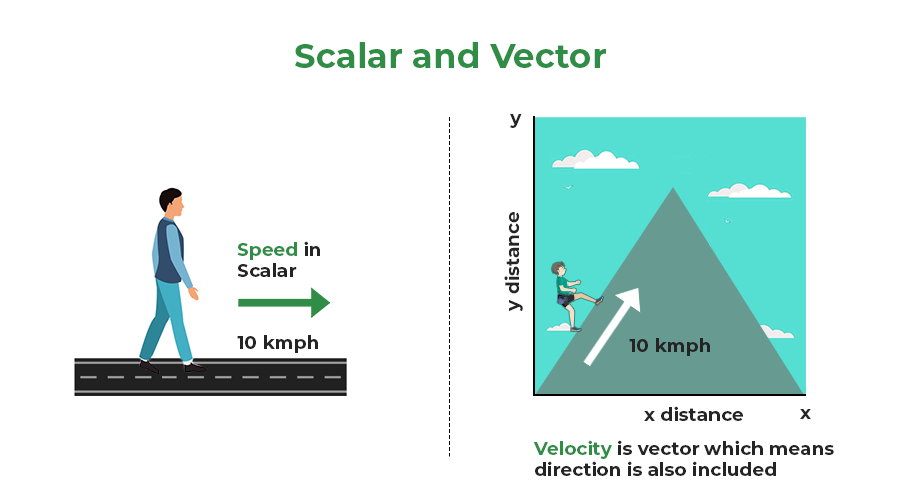
Vectors in Physics
Vectors in Physics
Name: Own Teacher
Email: info@ownteacher.com
Created At: 22-10-2023
Vectors are part of everyday life. When any person gives you directions, he may say something like; the school is 3 km that way and point. He gives you both a magnitude (a measurement) and a direction (by pointing). Vectors in Physics is an essential concept that one must master.
Plenty of situations in our life display vectors, and plenty of ideas in physics are vectors, too, for example, velocity, acceleration, and force, displacement. Vectors are fundamental.
Before we talk about vectors, let us talk about Physical Quantities first.
Physical Quantities:
The quantities that are measurable are called physical quantities. Ex. Length, mass, time, velocity. These quantities can be vectors, scalars, or tensors.
Vectors :
Vectors are those which have both magnitude and direction and also obey laws of vector addition.
Ex: Velocity, force momentum, torque, etc.
Scalars :
Scalars are those which have only magnitude.
Ex: Mass, Time, Distance, Flux.
Note: a physical quantity having magnitude and direction but not obeying the law of vector addition is treated as a scalar. Ex: Electric current is a scalar quantity.
Electric current is always associated with direction, but it is not a vector quantity. It does not obey the law of vector addition.
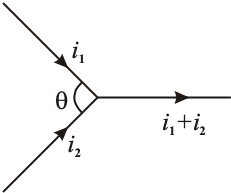
The resultant of i1 and i2 is (i1 + i2) by Kirchoff’s current law. The resultant does not depend on the angle between currents i1 and i2.
Tensors :
Tensors are those quantities having different magnitudes in different directions. These do not obey the laws of vector addition.
Ex: the moment of inertia, stress, etc.
Now let us discuss Vectors in detail.
More about Vector Quantities
Directions and magnitude of a vector :
When we have a vector, we must keep in mind two quantities: its direction and magnitude.
We see vectors drawn as arrows in physics, which is perfect because an arrow has both a clear direction and a clear magnitude (the length of the arrow)
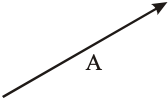
The arrow represents a vector that starts at the foot and ends at the head.
In physics, we use A to represent a vector. In some books, we see it with an arrow on top A. The arrow means that this is not only a scalar value which would be represented by A but also something with direction.
Why are vectors important?
Vectors are used in many branches of physics whenever there are quantities that we must describe in both magnitude and direction.
Vectors are used in many areas. E.g.:
- Vectors in physics
- vectors in kinematics
- vectors in engineering mechanics
- vectors linear algebra
- vector geometry etc.
The laws of electromagnetism and Maxwell’s equations are expressed in terms of vectors and vector field concepts. Vector operators such as the Gradient, divergence, and curl are often used in physics. Operations such as cross product and the dot product have many examples in physics. The cross product describes the Lorentz force, and mechanical work is expressed as the dot product of displacement and force vectors.
There is no division of vectors. Why?
Vectors are quantities with magnitudes as well as direction. Dividing a vector by another vector means we are dividing a direction by another direction, just like if we divide east by west. This does not make sense.
What is the triangle law of vector addition?
The triangle law of vector addition says that when two sides of the triangle represent two vectors with the order of magnitude and direction, the third side of the triangle represents the magnitude and direction of the resultant vector.
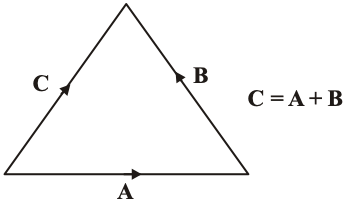
C is also known as the resultant vector.
Parallelogram rule of vector addition :
The parallelogram rule of vector addition says that if two vectors are assumed to be the adjacent sides of a parallelogram, then the resultant of these two vectors is given by the vector that is diagonal, passing through the contact point of two vectors (tail to tail).
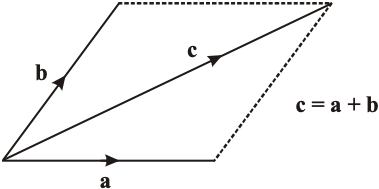
C is also called the resultant of a and b.
Vector arithmetic :
Addition of vectors :
Let A and B be the two vectors to be added. A diagram is drawn in which the starting point of B coincides with the ending point of A.
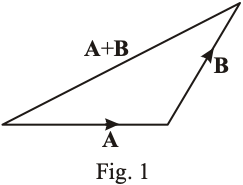
Here (A + B) is the resultant of A and B (triangle rule of vector addition).
Now, the same rule can be stated in a slightly different way. We draw the vectors A and B with both starting points coinciding, considering these two vectors as the adjacent sides. We complete parallelogram. The diagonal through the common tails give the sum of two vectors.
From fig 1, we can say AB + AC = AD.
Let, |A| = A and |B| = B.
|A| : magnitude of A & |B| : magnitude of B.
We are interested in calculating the magnitude and direction of (A + B).
Let the angle between A and B is thitha.
From fig.3,
Now, from fig.2, from right angle triangle AED.
The angle made by the resultant vector with A can be found from the right angle triangle AED.
Multiplication of a vector by a number :
Let A is a vector of magnitude A and C be a number. We define the vector B = CA as a vector of magnitude|CA|.
If C is positive, the direction of the vector B = CA is the same as that of A.
Multiplication by (–1) inverts the direction of the vector. The vectors A and –A have equal magnitudes but opposite directions.
Subtraction of vectors :
Let A and B be two co-initial vectors, as shown in the figure.
We define (A – B) as the vector A and (–B) sum. For subtracting B from A, we invert the direction of B and add to A.
Here, the angle between A and –B will be (180º– THITHA).
Unit vectors :
It is a vector whose magnitude is unity. A unit vector parallel to a given vector R is given by,
Orthogonal Unit vectors
Null vector or zero vector :
It is a vector of zero magnitude.
Its direction is indeterminate.
It is represented as O.
Position vector :
It is a vector that represents the position of a particle with respect to the origin of a coordinate system. The position vector of a point (x, y, z) can be written in the form:
The polar form of vector :
Multiplication of vectors :
A vector multiplied by another vector may give a scalar or a vector. Hence there are two types of products for the multiplication of two vectors.
(a) dot product or scalar product.
(b) cross product or vector product.
Scalar product or dot product :
The dot product, also known as the scalar product, is a mathematical operation that combines two vectors to produce a scalar value. It measures how closely two vectors align in terms of their directions . The dot product is denoted by a central dot (·) or by the symbol "⋅"
The dot product of two vectors a and b can be calculated using the following formulas:
- Formula 1: a · b = |a| |b| cos(θ), where |a| and |b| are the magnitudes (lengths) of vectors a and b, respectively, and θ is the angle between vectors a and b .
- Formula 2: a · b = ax bx + ay by, where ax and ay are the components of vector a, and bx and by are the components of vector b .
Both formulas yield the same result, and the dot product is always a scalar value .
Properties of the Dot Product
The dot product has several properties, including:
- Commutative: The dot product of vectors a and b is commutative, meaning that a · b = b · a .
- Distributive over vector addition: The dot product is distributive over vector addition, which means that (a + b) · c = a · c + b · c .
- Bilinear: The dot product is bilinear, which means that it satisfies the properties of scalar multiplication and addition .
- Orthogonal: Two non-zero vectors a and b are orthogonal if and only if their dot product is zero, i.e., a · b = 0 .
cross product or vector product :
The cross product, also known as the vector product, is an operation defined on two vectors in three-dimensional space. It results in a vector that is orthogonal (perpendicular) to both of the input vectors. The cross product is denoted by the symbol "×".
The cross product of two vectors, a and b, is calculated using the following formula:
a × b = |a| |b| sin(θ) n
where |a| and |b| are the magnitudes (lengths) of the vectors, θ is the angle between the vectors, and n is a unit vector perpendicular to the plane containing a and b.
The resulting vector points in a direction determined by the right-hand rule. If you curl the fingers of your right hand from the direction of a to b, then the direction in which your thumb points gives the direction of the cross product vector.
The magnitude of the cross product vector can be calculated using the formula:
|a × b| = |a| |b| sin(θ)
Cross Product Properties :
The cross product is useful in various areas of physics and mathematics, such as calculating torque, determining the normal vector to a plane, and solving problems involving angular momentum.
The cross product, also known as the vector product, has several properties that are important to understand. These properties help us manipulate and solve problems involving cross products. Let's explore some of these properties:
Anticommutativity: The cross product is anticommutative, which means that the order of the vectors matters. If we have two vectors A and B, then the cross product of A and B is equal to the negative of the cross product of B and A. Mathematically, this can be expressed as:
A × B = -(B × A)
This property is a consequence of the right-hand rule, which determines the direction of the resulting vector.
Distributivity: The cross product is distributive over vector addition. If we have three vectors A, B, and C, then the cross product of A and the sum of B and C is equal to the sum of the cross product of A and B and the cross product of A and C. Mathematically, this can be expressed as:
A × (B + C) = (A × B) + (A × C)
Scalar Multiplication: The cross product is compatible with scalar multiplication. If we have a scalar k and two vectors A and B, then the cross product of kA and B is equal to k times the cross product of A and B. Mathematically, this can be expressed as:
(kA) × B = k (A × B)
Zero Vector Property: If the cross product of two vectors is the zero vector, then either one or both of the input vectors is the zero vector, or they are parallel or antiparallel. In other words, if A × B = 0, then A = 0, B = 0, or A and B are parallel or antiparallel. This property arises from the fact that the sine of the angle between two parallel or antiparallel vectors is zero.
Jacobi Identity: The cross product satisfies the Jacobi identity, which is a property of the Lie bracket operation. The Jacobi identity states that for any three vectors A, B, and C, the following relationship holds:
A × (B × C) + B × (C × A) + C × (A × B) = 0
This property is important in the study of Lie algebras and their applications.
These properties help us manipulate and solve problems involving cross products. They provide a foundation for understanding the behavior of cross products and their applications in various fields, such as physics, engineering, and mathematics.
Comment List
Leave a Comment.



